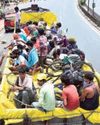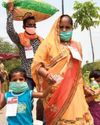Developments following the “cow protection” efforts of the government and other social organisations have not only crippled an already beleaguered livestock sector but also resulted in the proliferation of stray cattle, raising serious economic and ecological concerns.

THAT LIVESTOCK HAS BEEN ONE OF THE mainstays of rural economy the world over since prehistoric times is a widely accepted fact. In India, 20 million people are dependent on livestock for their livelihood. It is a reliable source of income for households in rural areas and contributes a substantial portion of the income of all rural households. The importance of livestock as livelihood is even more significant for small farm households, as their incomes from land are lower due to the small size of the landholdings. Consequently, it also contributes significantly to national income. In 2012-13, the livestock sector contributed 4.11 per cent of the total national gross domestic product and 25.6 per cent of the total agriculture GDP.
In India, unlike other countries, cattle rearing is mainly for milk production. Fragmentation of agricultural land and an increase in the demand for milk on account of rapid urbanisation made the dairy business popular among the unskilled and semi-skilled workforce in rural areas. Farmers as well as landless labourers found the business profitable. In 2013, the Akhilesh Yadav government in Uttar Pradesh started the Kamdhenu Yojana, which involved providing interest-free loans to milk producers. The scheme proved to be immensely popular, and Uttar Pradesh became the top producer of milk in the country.
この記事は FRONTLINE の November 10, 2017 版に掲載されています。
7 日間の Magzter GOLD 無料トライアルを開始して、何千もの厳選されたプレミアム ストーリー、9,000 以上の雑誌や新聞にアクセスしてください。
すでに購読者です ? サインイン
この記事は FRONTLINE の November 10, 2017 版に掲載されています。
7 日間の Magzter GOLD 無料トライアルを開始して、何千もの厳選されたプレミアム ストーリー、9,000 以上の雑誌や新聞にアクセスしてください。
すでに購読者です? サインイン

How Not To Handle An Epidemic
The lockdowns were meant to buy time to put in place appropriate health measures and contain the coronavirus’ spread, but they have failed to achieve the objective and heaped immense misery on the marginalised sections of society. India is still in the exponential phase of the COVID-19 infection and community transmission is a reality that the government refuses to accept.

Tragedy on foot
As the COVID-19-induced lockdown cuts the ground beneath their feet in Tamil Nadu, thousands of migrant workers are trudging along the highway to the relative safety of their upcountry homes.

Sarpanchs as game changers
Odisha manages to keep COVID-19 well under control because of the strong participation of panchayati raj institutions and the community at the grass-roots level under the leadership of Chief Minister Naveen Patnaik.

Scapegoating China
As the COVID-19 death rate spikes and the economy tanks in the United States, Donald Trump and his advisers target China and the World Health Organisation with an eye to winning the forthcoming presidential election.

New worries
Kerala’s measured approach to the pandemic and lockdown has yielded results. But it still has to grapple with their huge economic impact on its economy, which it feels the Centre’s special financial relief package does little to alleviate.
No love lost for labour
Taking advantage of the lockdown and the inability of workers to organise protests, many State governments introduce sweeping changes to labour laws to the detriment of workers on the pretext of reviving production and boosting the economy.

Capital's Malthusian moment
In a world that needs substantial reorienting of production and distribution, Indian capital is resorting to a militant form of moribund neoliberalism to overcome its current crisis. In this pursuit of profit, it is ready and willing to throw into mortal peril millions whom it adjudicates as not worth their means—an admixture of social Darwinism born of capital’s avarice and brutalism spawned by Hindutva. .

Understanding migration
When governments and their plans are found to be blatantly wanting in addressing reverse migration, exercises such as the Ekta Parishad’s survey of migrant workers throughout India can be useful to work out creative long-lasting solutions.

Waiting for Jabalpur moment
The Supreme Court’s role in ensuring executive accountability during the ongoing lockdown leaves much to be desired. Standing in shining contrast is the record of some High Courts.

An empty package
The Modi regime, which has been unable to control the COVID-19 infection, restore economic activity and provide relief to millions exposed to starvation, trains its sights on Indian democracy, making use of the panic generated by fear and a lockdown that forecloses paths of resistance.